Navajo Nation Resource and Development Committee (RDC) Site Tour of the Black Mesa and Kayenta Mine
On Wednesday, November 13, 2024, members of the Navajo Nation Resource and Development Committee (RDC) initiated a tour of the Black Mesa Coal Complex with Peabody Coal Company and other divisions of Navajo Nation Natural Resources. Members of Tó Nizhóní Ání joined the tour along with about 7 local mine residents.

This tour looked at the various parcels of land in different phases of reclamation, at the Black Mesa and Kayenta Mines. At one of the tour stops near the N-8 facility, a discussion came up about some of the amendments being made to the reclaimed areas. This prompted a question from one of the local community members who asked a crucial question on the seeps and springs that were once abundant in her area before mining began. “What about the natural springs that had disappeared? Is there going to be anything done about it? Said Lily Johnson from the area known as N-2 within the Kayenta Mine. “That was one of the things that we used to depend on for our livestock.”

Neither the Peabody Liaison, Marie Shepperd nor Navajo Nation Reclamation Specialist William Skeet provided a clear answer to the question. Ms. Sheppard directed any questions to the annual report which was located at the chapters and Mr. Skeet, told Lily that the problems with loss springs were due to the drought. We asked if there was a process that either Peabody or the Navajo Nation follows to determine if a spring was lost to draught or mining. Again neither Ms. Sheppard nor Mr. Skeet answered the question. Instead of offering the Nations process, Mr. Skeet directed questions on springs and well data to the local chapter house. “It’s documented, but what if the spring is not producing than what’s the steps?” said again, TNA member and Black Mesa resident, Nicole Horseherder, asked “What’s the process of the spring that’s been mined through. [How are you all keeping track of these springs] after this happened. [Are you all not keeping track of it?].” Although there was a response from the OSM Navajo representative, it provided no insight into the Navajo Nation’s process to determine impacts from mining and how it addresses the loss of the seeps and springs on Black Mesa from coal mining.
After lunch the tour continued with stops at N6, N11, N14, J16, J28, J19, and J21. Of all the stops that were made at the Kayenta Mine, J19 was the only location that was in the process of back filling. This tour provided tremendous insight into the sheer magnitude of the mining operation on Black Mesa and continues to remind us of its impact on the region and people. Tó Nizhóní Ání would like to thank RDC for scheduling this tour and allowing the local community to be a part of it.






